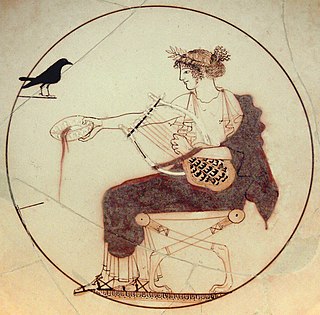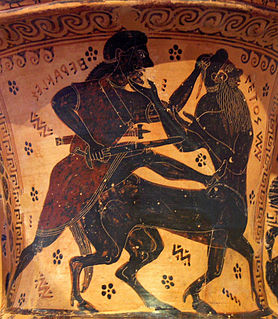
Black-figure pottery painting, also known as the black-figure style or black-figure ceramic, is one of the styles of painting on antique Greek vases. It was especially common between the 7th and 5th centuries BC, although there are specimens dating as late as the 2nd century BC. Stylistically it can be distinguished from the preceding orientalizing period and the subsequent red-figure pottery style.

Red-figure vase painting is one of the most important styles of figural Greek vase painting.

The Affecter was an Attic black-figure vase painter, active in Athens around 550 to 530 BCE.

White-ground technique is a style of white ancient Greek pottery and the painting in which figures appear on a white background. It developed in the region of Attica, dated to about 500 BC. It was especially associated with vases made for ritual and funerary use, if only because the painted surface was more fragile than in the other main techniques of black-figure and red-figure vase painting. Nevertheless, a wide range of subjects are depicted.

The Kerch style, also referred to as Kerch vases, is an archaeological term describing vases from the final phase of Attic red-figure pottery production. Their exact chronology remains problematic, but they are generally assumed to have been produced roughly between 375 and 330/20 BC. The style is characterized by slender mannered figures and a polychromatism given to it by the use of white paint and gilding.

The Nessos Painter, also known as Netos or Nettos Painter, was a pioneer of Attic black-figure vase painting. He is considered to be the first Athenian to adopt the Corinthian style who went on to develop his own style and introduced innovations. The Nessos Painter is often known to be one of the original painters of black-figure. He only worked in this style, which is shown on his name vase in the National Archaeological Museum in Athens. Most of the known Nessos Painter ceramics were found in funerary settings such as cemeteries and mortuaries.

Andokides was an ancient Athenian vase painter, active from approximately 530 to 515 B.C. His work is unsigned and his true name unknown. He was identified as a unique artistic personality through stylistic traits found in common among several paintings. This corpus was then attributed by John D. Beazley to the Andokides Painter, a name derived from the potter Andokides, whose signature appears on several of the vases bearing the painter's work. He is often credited with being the originator of the red-figure vase painting technique. To be sure, he is certainly one of the earliest painters to work in the style. In total, fourteen amphorae and two cups are attributed to his hand. Six of the amphorae are "bilingual", meaning they display both red-figure and black-figure scenes.

The Reed Painter is an anonymous Greek vase painter of white-ground lekythoi, a type of vessel for containing oil often left as grave offerings. Works are attributed to either the "Reed Painter" or his atelier.

The Painter of Berlin A 34 was a vase painter during the pioneering period of Attic black-figure pottery. His real name is unknown, his conventional name derived from his name vase in the Antikensammlung Berlin. He is the first individual vase painter of the style in Athens recognised by scholarship. His works are dated to circa 630 BC. Two of his vases were discovered in Aegina. Since the 19th century, those pieces were on display in Berlin, but they disappeared or were destroyed during the Second World War.

The Anagyros Painter or Anagyrus Painter was a vase painter of the early Attic black-figure style, active in the first quarter of the 6th century BC. His works have only been found in inland Attica, mainly at Vari, but not in Athens itself. It is thus assumed that he was not active within the city and only produced for a very limited rural area. In contrast to many of his contemporaries, he did not paint lekanes but various large formats, such as amphorae, kantharoi, chalices, oinochoai and plates.
The Painter of the Dresden Lekanis is the common name for a vase painter of the Attic black-figure style, active around 580–570 BC. He emigrated to Boeotia and is in fact identical with the Boeotian Horse-bird Painter.

The Goltyr Painter was an Attic vase painter of the black-figure style. He was active in the second quarter of the sixth century BC. He is well known for his work on Tyrrhenian amphorae. He mostly painted animals, often with rather bulbous heads.

The Phrynos Painter was an Attic black-figure vase painter, active in Athens between c. 560 and 545 BC. He was allocated the conventional name "Phrynos Painter" after the potter Phrynos, as he had painted three cups signed by the latter:
The Xenokles Painter was an Attic vase painter in the black-figure style, active around the middle of the 6th century BC. His real name is unknown. His conventional name is based on the fact that he often painted vases made by the potter Xenokles, with whom he may be identical. In artistic terms, he did not reach the talent of comparable painters, such as the Tleson Painter. Characteristic of his work is his habit of cramming lip cups with figures, comparable to the normal decoration of Siana cups.

The Leagros Group was a group of Attic black-figure vase painters active during the last two decades of the 6th century BC. The name given to the group by modern scholars is a conventional one, derived from a series of name vases.

The Rycroft Painter was an Attic late black-figure vase painter, active in the final decade of the sixth century BC. His real name is not known.

The term Perizoma Group describes a group of Attic black-figure vase painters and a type of vase. They were active approximately 520–510 BC.

The Euphiletos Painter was an Attic black-figure vase painter active in the second half of the sixth century BC.

The Madrid Painter was an Attic black-figure vase painter active during the late period of the style, around 520 BC.

Sicilian vase painting was a regional style of South Italian red-figure vase painting. It was one of five South Italian regional styles. The vase painting of Sicily was especially closely connected with the Lucanian and Paestan styles.
This page is based on this
Wikipedia article Text is available under the
CC BY-SA 4.0 license; additional terms may apply.
Images, videos and audio are available under their respective licenses.


















